Nursing Assignment: Analysis of Anna and George's Case Studies Data
VerifiedAdded on 2023/06/04
|8
|2617
|414
Essay
AI Summary
This nursing assignment presents an in-depth analysis of two case studies, Anna and George, focusing on their respective health challenges of dehydration and postural hypotension. The essay begins by identifying and interpreting the relevant assessment data from each case, relating them to underlying pathophysiological processes and highlighting the similarities and differences in their clinical presentations. The assignment then defines specific, measurable, achievable, realistic, and time-bound (SMART) goals for effective patient care. Furthermore, it examines two crucial interventions, including a nurse-initiated intervention, to address the identified health problems, supported by a critical analysis of current evidence. The essay also explores how these interventions would be adapted to accommodate the unique developmental needs of each patient. The essay discusses how to evaluate the implemented care for each case, the physical changes that would indicate the intervention has been effective, and how subsequent assessment would be modified to ensure accurate data is collected and individual needs are met. The essay concludes with implications for healthcare professionals in treating patients with postural hypotension and poor hydration, emphasizing effective healthcare services, nurses' roles, and psychosocial care.
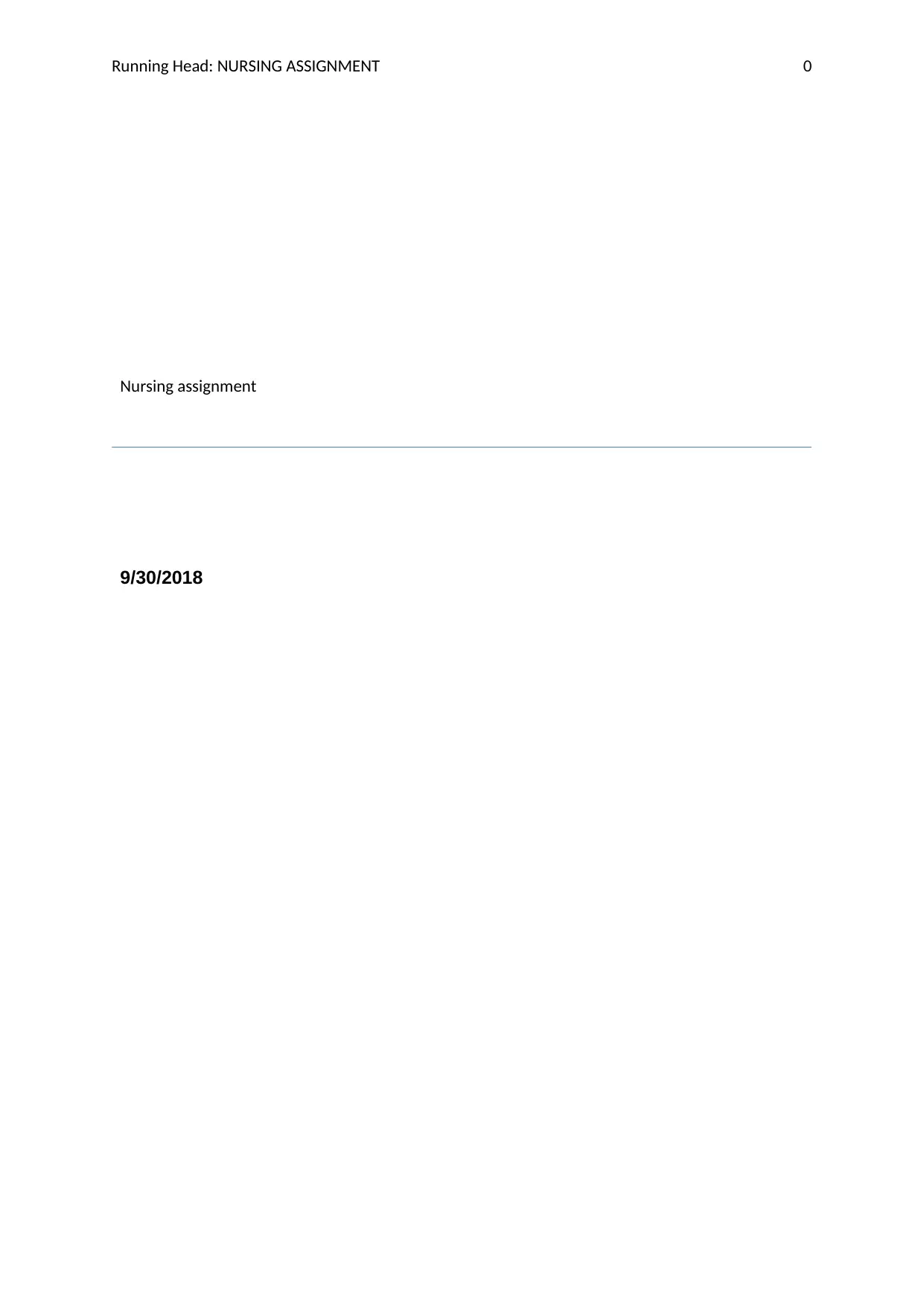
Running Head: NURSING ASSIGNMENT 0
Nursing assignment
9/30/2018
Nursing assignment
9/30/2018
Paraphrase This Document
Need a fresh take? Get an instant paraphrase of this document with our AI Paraphraser
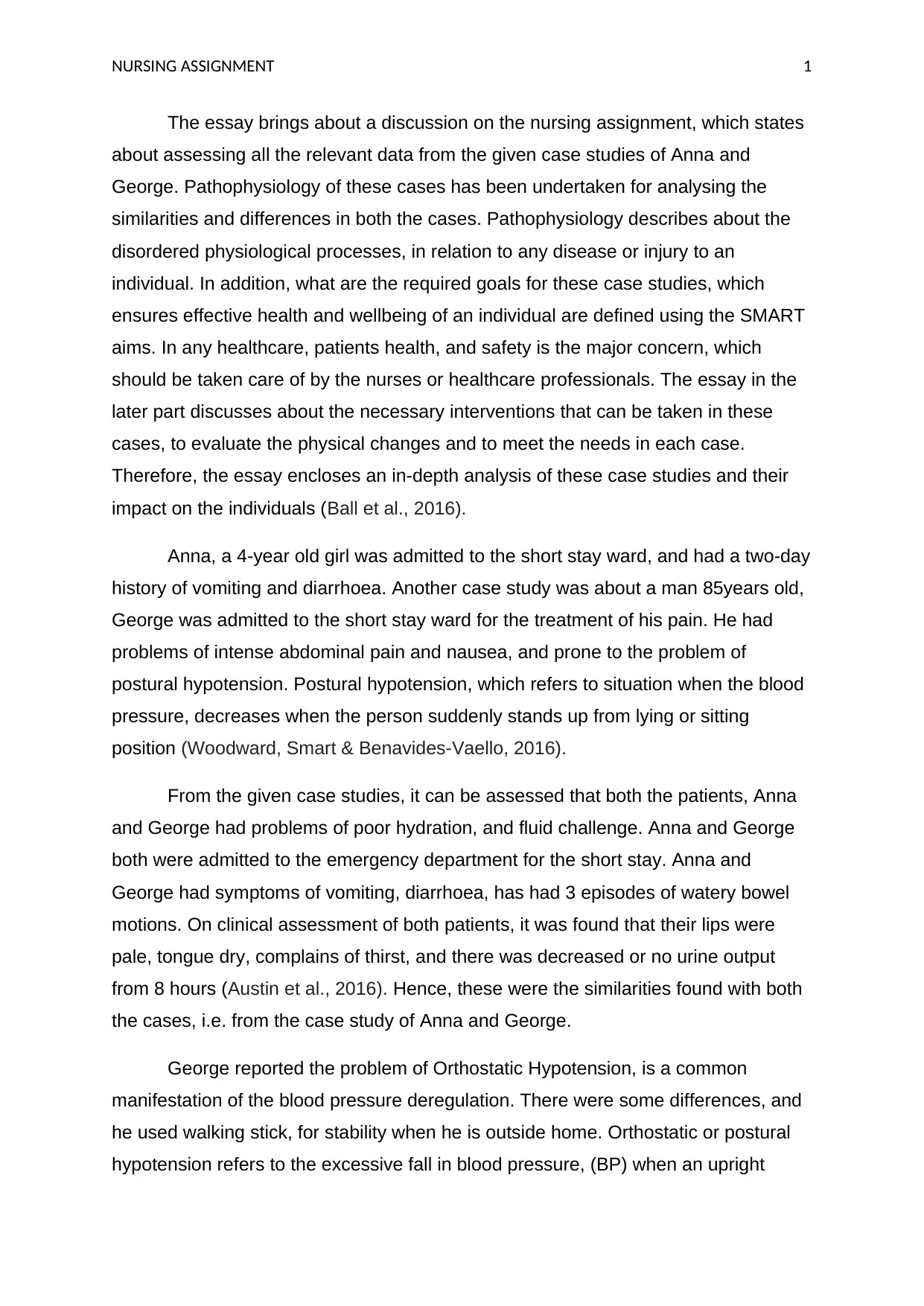
NURSING ASSIGNMENT 1
The essay brings about a discussion on the nursing assignment, which states
about assessing all the relevant data from the given case studies of Anna and
George. Pathophysiology of these cases has been undertaken for analysing the
similarities and differences in both the cases. Pathophysiology describes about the
disordered physiological processes, in relation to any disease or injury to an
individual. In addition, what are the required goals for these case studies, which
ensures effective health and wellbeing of an individual are defined using the SMART
aims. In any healthcare, patients health, and safety is the major concern, which
should be taken care of by the nurses or healthcare professionals. The essay in the
later part discusses about the necessary interventions that can be taken in these
cases, to evaluate the physical changes and to meet the needs in each case.
Therefore, the essay encloses an in-depth analysis of these case studies and their
impact on the individuals (Ball et al., 2016).
Anna, a 4-year old girl was admitted to the short stay ward, and had a two-day
history of vomiting and diarrhoea. Another case study was about a man 85years old,
George was admitted to the short stay ward for the treatment of his pain. He had
problems of intense abdominal pain and nausea, and prone to the problem of
postural hypotension. Postural hypotension, which refers to situation when the blood
pressure, decreases when the person suddenly stands up from lying or sitting
position (Woodward, Smart & Benavides-Vaello, 2016).
From the given case studies, it can be assessed that both the patients, Anna
and George had problems of poor hydration, and fluid challenge. Anna and George
both were admitted to the emergency department for the short stay. Anna and
George had symptoms of vomiting, diarrhoea, has had 3 episodes of watery bowel
motions. On clinical assessment of both patients, it was found that their lips were
pale, tongue dry, complains of thirst, and there was decreased or no urine output
from 8 hours (Austin et al., 2016). Hence, these were the similarities found with both
the cases, i.e. from the case study of Anna and George.
George reported the problem of Orthostatic Hypotension, is a common
manifestation of the blood pressure deregulation. There were some differences, and
he used walking stick, for stability when he is outside home. Orthostatic or postural
hypotension refers to the excessive fall in blood pressure, (BP) when an upright
The essay brings about a discussion on the nursing assignment, which states
about assessing all the relevant data from the given case studies of Anna and
George. Pathophysiology of these cases has been undertaken for analysing the
similarities and differences in both the cases. Pathophysiology describes about the
disordered physiological processes, in relation to any disease or injury to an
individual. In addition, what are the required goals for these case studies, which
ensures effective health and wellbeing of an individual are defined using the SMART
aims. In any healthcare, patients health, and safety is the major concern, which
should be taken care of by the nurses or healthcare professionals. The essay in the
later part discusses about the necessary interventions that can be taken in these
cases, to evaluate the physical changes and to meet the needs in each case.
Therefore, the essay encloses an in-depth analysis of these case studies and their
impact on the individuals (Ball et al., 2016).
Anna, a 4-year old girl was admitted to the short stay ward, and had a two-day
history of vomiting and diarrhoea. Another case study was about a man 85years old,
George was admitted to the short stay ward for the treatment of his pain. He had
problems of intense abdominal pain and nausea, and prone to the problem of
postural hypotension. Postural hypotension, which refers to situation when the blood
pressure, decreases when the person suddenly stands up from lying or sitting
position (Woodward, Smart & Benavides-Vaello, 2016).
From the given case studies, it can be assessed that both the patients, Anna
and George had problems of poor hydration, and fluid challenge. Anna and George
both were admitted to the emergency department for the short stay. Anna and
George had symptoms of vomiting, diarrhoea, has had 3 episodes of watery bowel
motions. On clinical assessment of both patients, it was found that their lips were
pale, tongue dry, complains of thirst, and there was decreased or no urine output
from 8 hours (Austin et al., 2016). Hence, these were the similarities found with both
the cases, i.e. from the case study of Anna and George.
George reported the problem of Orthostatic Hypotension, is a common
manifestation of the blood pressure deregulation. There were some differences, and
he used walking stick, for stability when he is outside home. Orthostatic or postural
hypotension refers to the excessive fall in blood pressure, (BP) when an upright
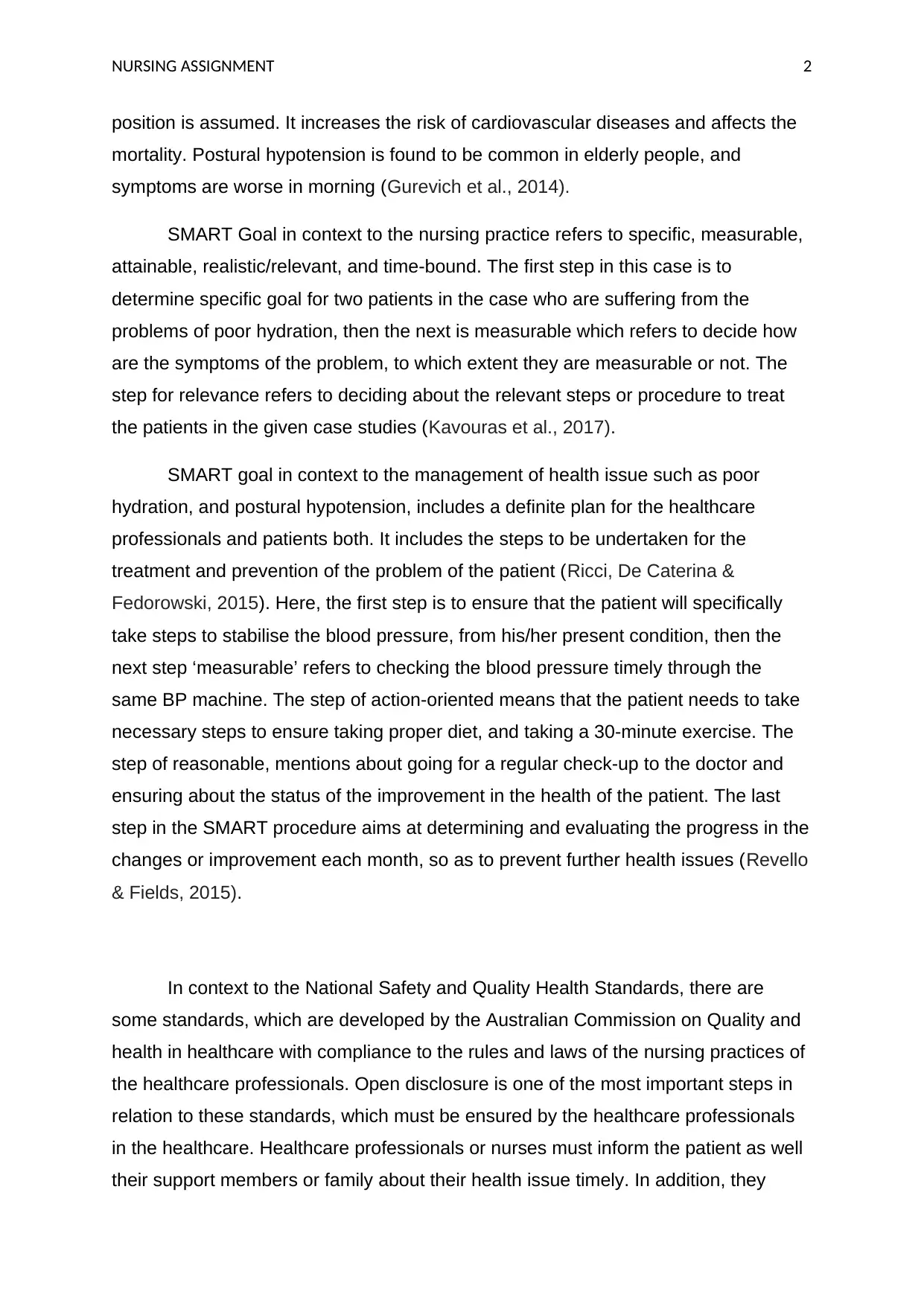
NURSING ASSIGNMENT 2
position is assumed. It increases the risk of cardiovascular diseases and affects the
mortality. Postural hypotension is found to be common in elderly people, and
symptoms are worse in morning (Gurevich et al., 2014).
SMART Goal in context to the nursing practice refers to specific, measurable,
attainable, realistic/relevant, and time-bound. The first step in this case is to
determine specific goal for two patients in the case who are suffering from the
problems of poor hydration, then the next is measurable which refers to decide how
are the symptoms of the problem, to which extent they are measurable or not. The
step for relevance refers to deciding about the relevant steps or procedure to treat
the patients in the given case studies (Kavouras et al., 2017).
SMART goal in context to the management of health issue such as poor
hydration, and postural hypotension, includes a definite plan for the healthcare
professionals and patients both. It includes the steps to be undertaken for the
treatment and prevention of the problem of the patient (Ricci, De Caterina &
Fedorowski, 2015). Here, the first step is to ensure that the patient will specifically
take steps to stabilise the blood pressure, from his/her present condition, then the
next step ‘measurable’ refers to checking the blood pressure timely through the
same BP machine. The step of action-oriented means that the patient needs to take
necessary steps to ensure taking proper diet, and taking a 30-minute exercise. The
step of reasonable, mentions about going for a regular check-up to the doctor and
ensuring about the status of the improvement in the health of the patient. The last
step in the SMART procedure aims at determining and evaluating the progress in the
changes or improvement each month, so as to prevent further health issues (Revello
& Fields, 2015).
In context to the National Safety and Quality Health Standards, there are
some standards, which are developed by the Australian Commission on Quality and
health in healthcare with compliance to the rules and laws of the nursing practices of
the healthcare professionals. Open disclosure is one of the most important steps in
relation to these standards, which must be ensured by the healthcare professionals
in the healthcare. Healthcare professionals or nurses must inform the patient as well
their support members or family about their health issue timely. In addition, they
position is assumed. It increases the risk of cardiovascular diseases and affects the
mortality. Postural hypotension is found to be common in elderly people, and
symptoms are worse in morning (Gurevich et al., 2014).
SMART Goal in context to the nursing practice refers to specific, measurable,
attainable, realistic/relevant, and time-bound. The first step in this case is to
determine specific goal for two patients in the case who are suffering from the
problems of poor hydration, then the next is measurable which refers to decide how
are the symptoms of the problem, to which extent they are measurable or not. The
step for relevance refers to deciding about the relevant steps or procedure to treat
the patients in the given case studies (Kavouras et al., 2017).
SMART goal in context to the management of health issue such as poor
hydration, and postural hypotension, includes a definite plan for the healthcare
professionals and patients both. It includes the steps to be undertaken for the
treatment and prevention of the problem of the patient (Ricci, De Caterina &
Fedorowski, 2015). Here, the first step is to ensure that the patient will specifically
take steps to stabilise the blood pressure, from his/her present condition, then the
next step ‘measurable’ refers to checking the blood pressure timely through the
same BP machine. The step of action-oriented means that the patient needs to take
necessary steps to ensure taking proper diet, and taking a 30-minute exercise. The
step of reasonable, mentions about going for a regular check-up to the doctor and
ensuring about the status of the improvement in the health of the patient. The last
step in the SMART procedure aims at determining and evaluating the progress in the
changes or improvement each month, so as to prevent further health issues (Revello
& Fields, 2015).
In context to the National Safety and Quality Health Standards, there are
some standards, which are developed by the Australian Commission on Quality and
health in healthcare with compliance to the rules and laws of the nursing practices of
the healthcare professionals. Open disclosure is one of the most important steps in
relation to these standards, which must be ensured by the healthcare professionals
in the healthcare. Healthcare professionals or nurses must inform the patient as well
their support members or family about their health issue timely. In addition, they
⊘ This is a preview!⊘
Do you want full access?
Subscribe today to unlock all pages.

Trusted by 1+ million students worldwide
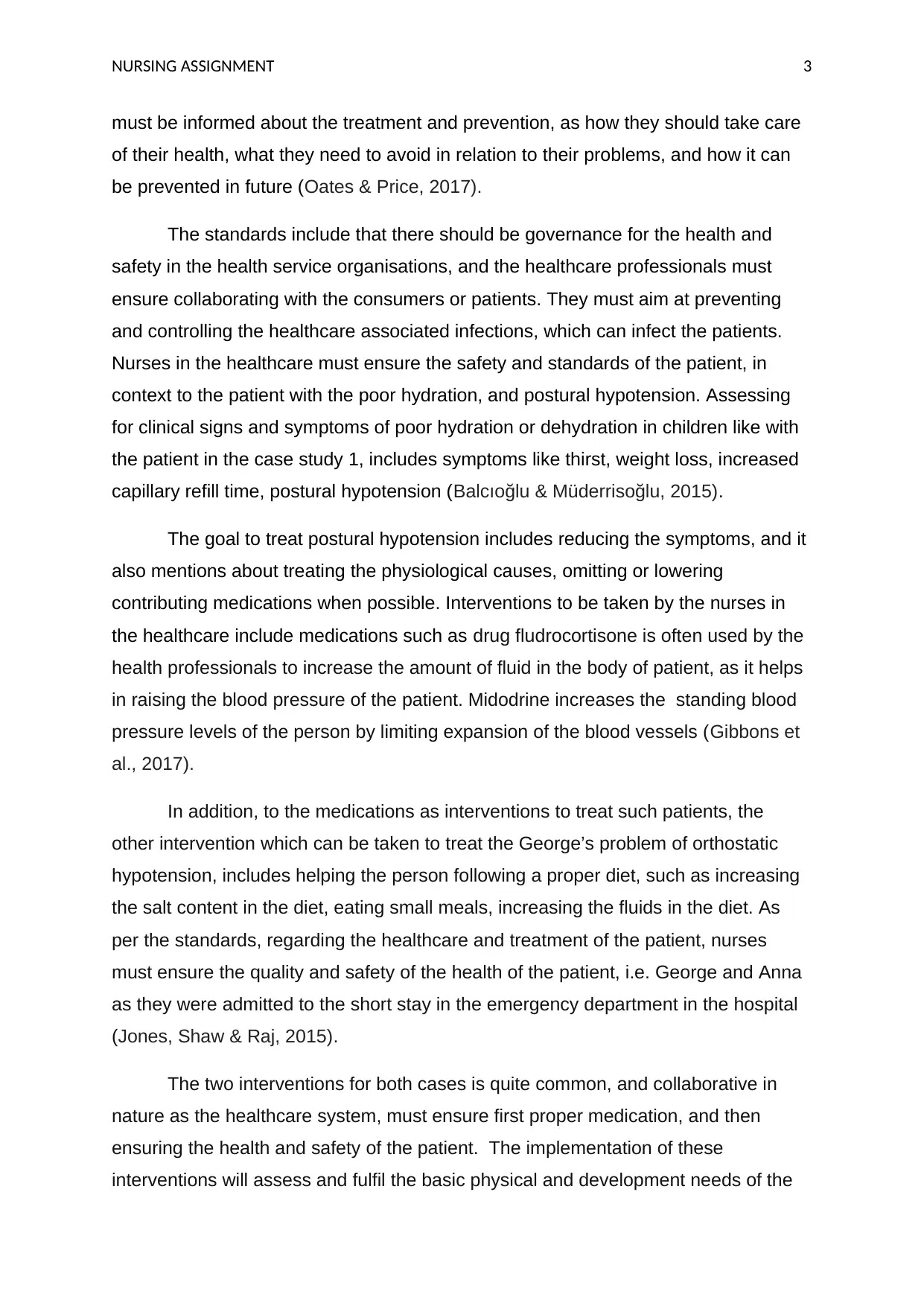
NURSING ASSIGNMENT 3
must be informed about the treatment and prevention, as how they should take care
of their health, what they need to avoid in relation to their problems, and how it can
be prevented in future (Oates & Price, 2017).
The standards include that there should be governance for the health and
safety in the health service organisations, and the healthcare professionals must
ensure collaborating with the consumers or patients. They must aim at preventing
and controlling the healthcare associated infections, which can infect the patients.
Nurses in the healthcare must ensure the safety and standards of the patient, in
context to the patient with the poor hydration, and postural hypotension. Assessing
for clinical signs and symptoms of poor hydration or dehydration in children like with
the patient in the case study 1, includes symptoms like thirst, weight loss, increased
capillary refill time, postural hypotension (Balcıoğlu & Müderrisoğlu, 2015).
The goal to treat postural hypotension includes reducing the symptoms, and it
also mentions about treating the physiological causes, omitting or lowering
contributing medications when possible. Interventions to be taken by the nurses in
the healthcare include medications such as drug fludrocortisone is often used by the
health professionals to increase the amount of fluid in the body of patient, as it helps
in raising the blood pressure of the patient. Midodrine increases the standing blood
pressure levels of the person by limiting expansion of the blood vessels (Gibbons et
al., 2017).
In addition, to the medications as interventions to treat such patients, the
other intervention which can be taken to treat the George’s problem of orthostatic
hypotension, includes helping the person following a proper diet, such as increasing
the salt content in the diet, eating small meals, increasing the fluids in the diet. As
per the standards, regarding the healthcare and treatment of the patient, nurses
must ensure the quality and safety of the health of the patient, i.e. George and Anna
as they were admitted to the short stay in the emergency department in the hospital
(Jones, Shaw & Raj, 2015).
The two interventions for both cases is quite common, and collaborative in
nature as the healthcare system, must ensure first proper medication, and then
ensuring the health and safety of the patient. The implementation of these
interventions will assess and fulfil the basic physical and development needs of the
must be informed about the treatment and prevention, as how they should take care
of their health, what they need to avoid in relation to their problems, and how it can
be prevented in future (Oates & Price, 2017).
The standards include that there should be governance for the health and
safety in the health service organisations, and the healthcare professionals must
ensure collaborating with the consumers or patients. They must aim at preventing
and controlling the healthcare associated infections, which can infect the patients.
Nurses in the healthcare must ensure the safety and standards of the patient, in
context to the patient with the poor hydration, and postural hypotension. Assessing
for clinical signs and symptoms of poor hydration or dehydration in children like with
the patient in the case study 1, includes symptoms like thirst, weight loss, increased
capillary refill time, postural hypotension (Balcıoğlu & Müderrisoğlu, 2015).
The goal to treat postural hypotension includes reducing the symptoms, and it
also mentions about treating the physiological causes, omitting or lowering
contributing medications when possible. Interventions to be taken by the nurses in
the healthcare include medications such as drug fludrocortisone is often used by the
health professionals to increase the amount of fluid in the body of patient, as it helps
in raising the blood pressure of the patient. Midodrine increases the standing blood
pressure levels of the person by limiting expansion of the blood vessels (Gibbons et
al., 2017).
In addition, to the medications as interventions to treat such patients, the
other intervention which can be taken to treat the George’s problem of orthostatic
hypotension, includes helping the person following a proper diet, such as increasing
the salt content in the diet, eating small meals, increasing the fluids in the diet. As
per the standards, regarding the healthcare and treatment of the patient, nurses
must ensure the quality and safety of the health of the patient, i.e. George and Anna
as they were admitted to the short stay in the emergency department in the hospital
(Jones, Shaw & Raj, 2015).
The two interventions for both cases is quite common, and collaborative in
nature as the healthcare system, must ensure first proper medication, and then
ensuring the health and safety of the patient. The implementation of these
interventions will assess and fulfil the basic physical and development needs of the
Paraphrase This Document
Need a fresh take? Get an instant paraphrase of this document with our AI Paraphraser
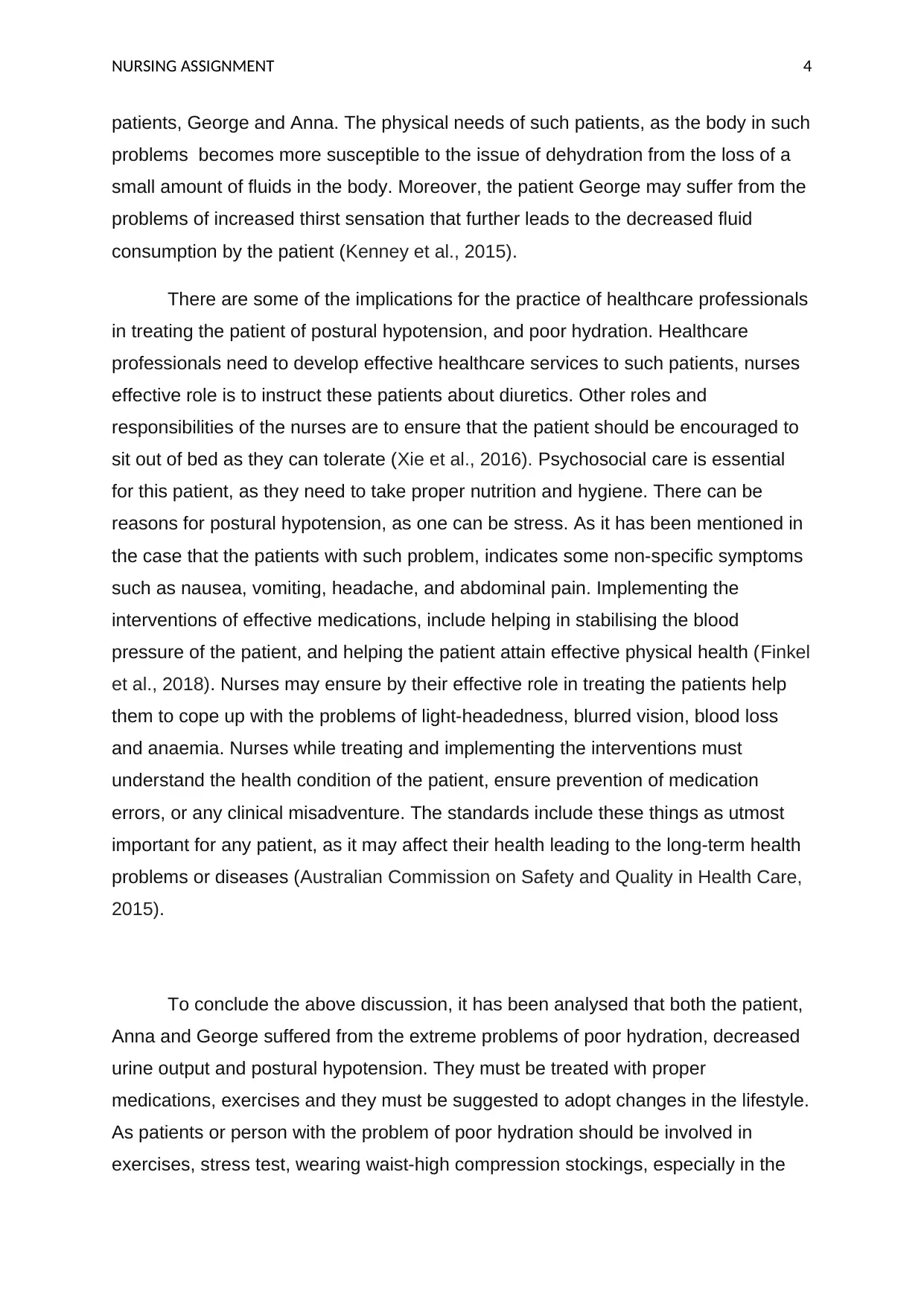
NURSING ASSIGNMENT 4
patients, George and Anna. The physical needs of such patients, as the body in such
problems becomes more susceptible to the issue of dehydration from the loss of a
small amount of fluids in the body. Moreover, the patient George may suffer from the
problems of increased thirst sensation that further leads to the decreased fluid
consumption by the patient (Kenney et al., 2015).
There are some of the implications for the practice of healthcare professionals
in treating the patient of postural hypotension, and poor hydration. Healthcare
professionals need to develop effective healthcare services to such patients, nurses
effective role is to instruct these patients about diuretics. Other roles and
responsibilities of the nurses are to ensure that the patient should be encouraged to
sit out of bed as they can tolerate (Xie et al., 2016). Psychosocial care is essential
for this patient, as they need to take proper nutrition and hygiene. There can be
reasons for postural hypotension, as one can be stress. As it has been mentioned in
the case that the patients with such problem, indicates some non-specific symptoms
such as nausea, vomiting, headache, and abdominal pain. Implementing the
interventions of effective medications, include helping in stabilising the blood
pressure of the patient, and helping the patient attain effective physical health (Finkel
et al., 2018). Nurses may ensure by their effective role in treating the patients help
them to cope up with the problems of light-headedness, blurred vision, blood loss
and anaemia. Nurses while treating and implementing the interventions must
understand the health condition of the patient, ensure prevention of medication
errors, or any clinical misadventure. The standards include these things as utmost
important for any patient, as it may affect their health leading to the long-term health
problems or diseases (Australian Commission on Safety and Quality in Health Care,
2015).
To conclude the above discussion, it has been analysed that both the patient,
Anna and George suffered from the extreme problems of poor hydration, decreased
urine output and postural hypotension. They must be treated with proper
medications, exercises and they must be suggested to adopt changes in the lifestyle.
As patients or person with the problem of poor hydration should be involved in
exercises, stress test, wearing waist-high compression stockings, especially in the
patients, George and Anna. The physical needs of such patients, as the body in such
problems becomes more susceptible to the issue of dehydration from the loss of a
small amount of fluids in the body. Moreover, the patient George may suffer from the
problems of increased thirst sensation that further leads to the decreased fluid
consumption by the patient (Kenney et al., 2015).
There are some of the implications for the practice of healthcare professionals
in treating the patient of postural hypotension, and poor hydration. Healthcare
professionals need to develop effective healthcare services to such patients, nurses
effective role is to instruct these patients about diuretics. Other roles and
responsibilities of the nurses are to ensure that the patient should be encouraged to
sit out of bed as they can tolerate (Xie et al., 2016). Psychosocial care is essential
for this patient, as they need to take proper nutrition and hygiene. There can be
reasons for postural hypotension, as one can be stress. As it has been mentioned in
the case that the patients with such problem, indicates some non-specific symptoms
such as nausea, vomiting, headache, and abdominal pain. Implementing the
interventions of effective medications, include helping in stabilising the blood
pressure of the patient, and helping the patient attain effective physical health (Finkel
et al., 2018). Nurses may ensure by their effective role in treating the patients help
them to cope up with the problems of light-headedness, blurred vision, blood loss
and anaemia. Nurses while treating and implementing the interventions must
understand the health condition of the patient, ensure prevention of medication
errors, or any clinical misadventure. The standards include these things as utmost
important for any patient, as it may affect their health leading to the long-term health
problems or diseases (Australian Commission on Safety and Quality in Health Care,
2015).
To conclude the above discussion, it has been analysed that both the patient,
Anna and George suffered from the extreme problems of poor hydration, decreased
urine output and postural hypotension. They must be treated with proper
medications, exercises and they must be suggested to adopt changes in the lifestyle.
As patients or person with the problem of poor hydration should be involved in
exercises, stress test, wearing waist-high compression stockings, especially in the
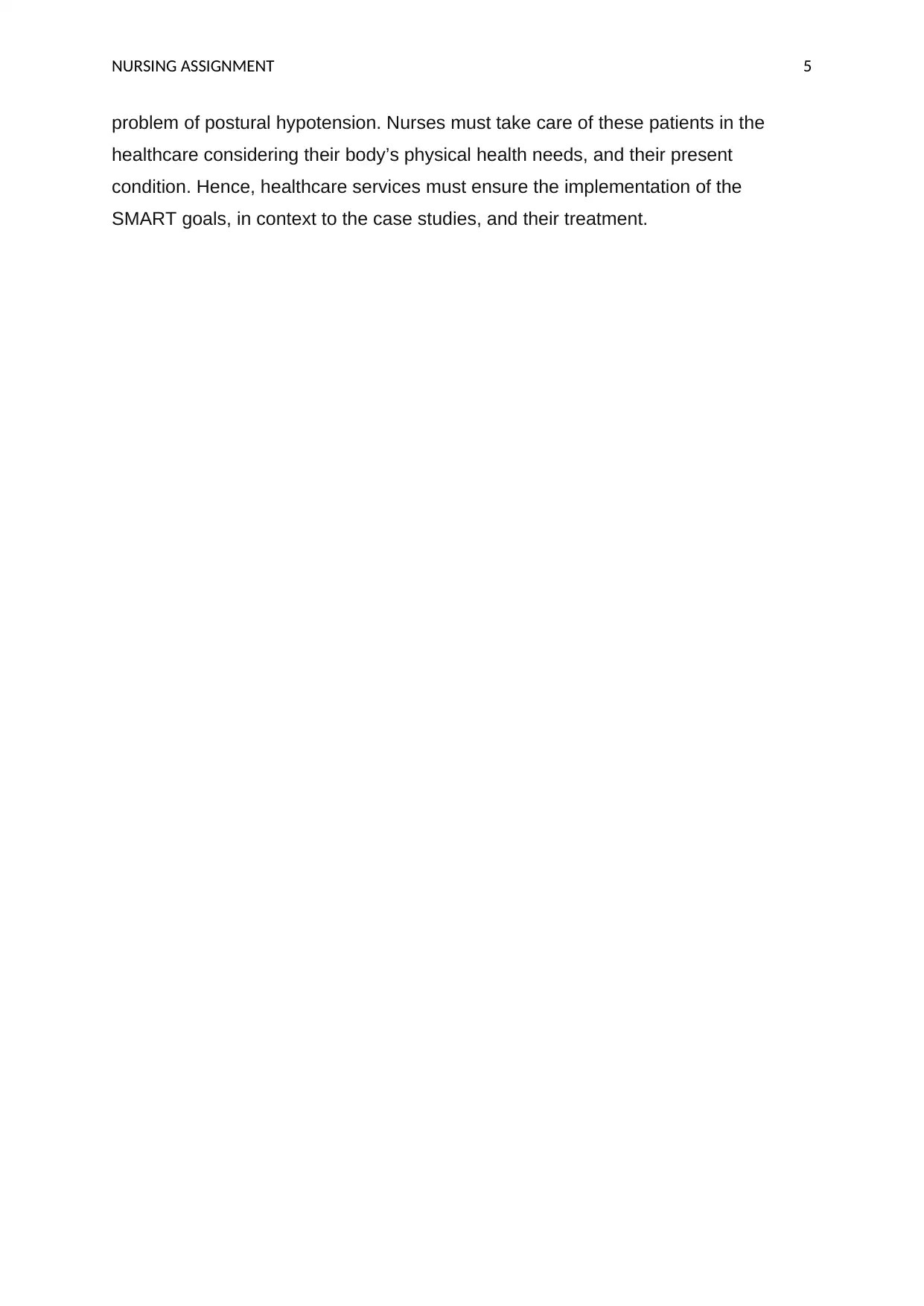
NURSING ASSIGNMENT 5
problem of postural hypotension. Nurses must take care of these patients in the
healthcare considering their body’s physical health needs, and their present
condition. Hence, healthcare services must ensure the implementation of the
SMART goals, in context to the case studies, and their treatment.
problem of postural hypotension. Nurses must take care of these patients in the
healthcare considering their body’s physical health needs, and their present
condition. Hence, healthcare services must ensure the implementation of the
SMART goals, in context to the case studies, and their treatment.
⊘ This is a preview!⊘
Do you want full access?
Subscribe today to unlock all pages.

Trusted by 1+ million students worldwide
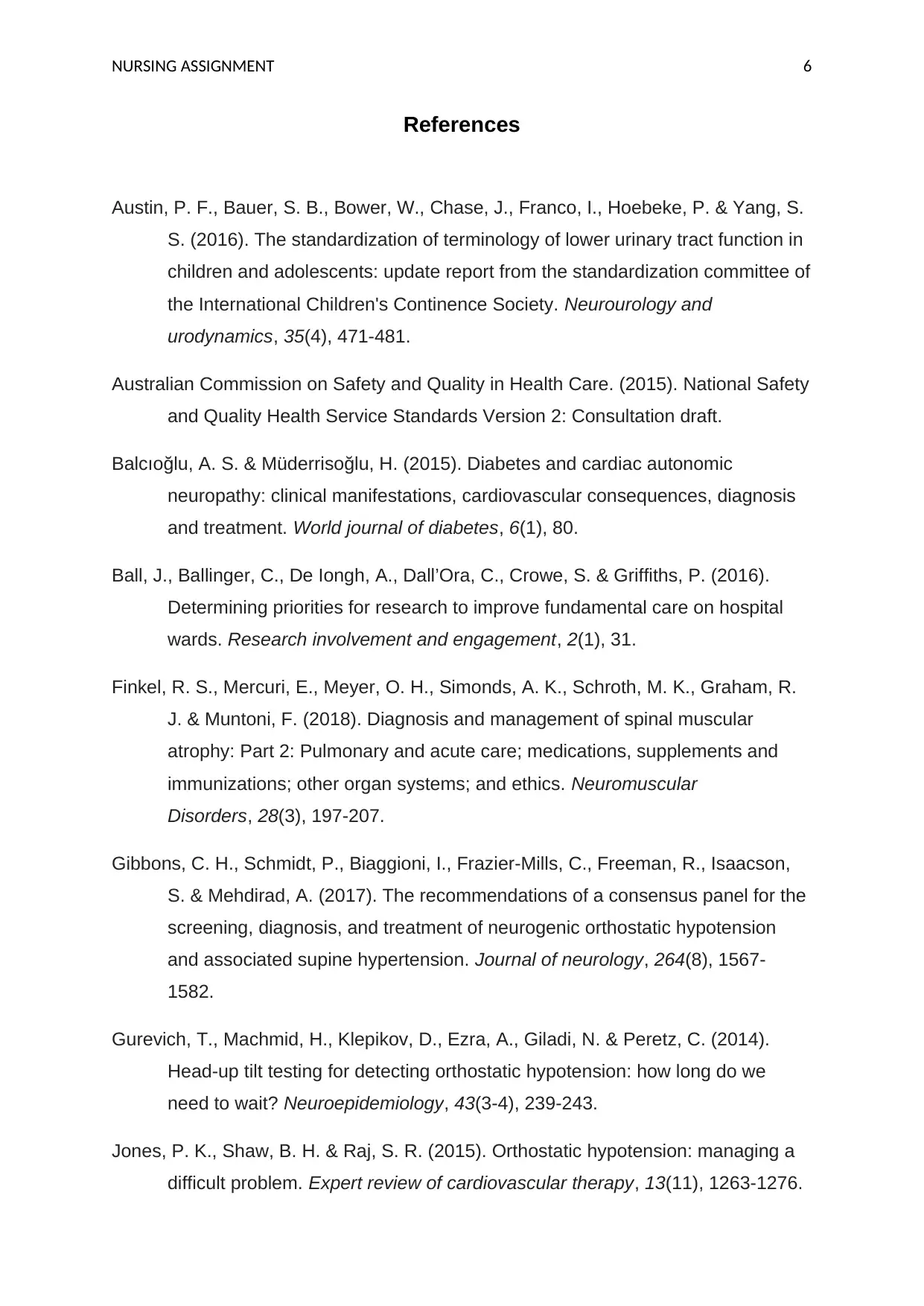
NURSING ASSIGNMENT 6
References
Austin, P. F., Bauer, S. B., Bower, W., Chase, J., Franco, I., Hoebeke, P. & Yang, S.
S. (2016). The standardization of terminology of lower urinary tract function in
children and adolescents: update report from the standardization committee of
the International Children's Continence Society. Neurourology and
urodynamics, 35(4), 471-481.
Australian Commission on Safety and Quality in Health Care. (2015). National Safety
and Quality Health Service Standards Version 2: Consultation draft.
Balcıoğlu, A. S. & Müderrisoğlu, H. (2015). Diabetes and cardiac autonomic
neuropathy: clinical manifestations, cardiovascular consequences, diagnosis
and treatment. World journal of diabetes, 6(1), 80.
Ball, J., Ballinger, C., De Iongh, A., Dall’Ora, C., Crowe, S. & Griffiths, P. (2016).
Determining priorities for research to improve fundamental care on hospital
wards. Research involvement and engagement, 2(1), 31.
Finkel, R. S., Mercuri, E., Meyer, O. H., Simonds, A. K., Schroth, M. K., Graham, R.
J. & Muntoni, F. (2018). Diagnosis and management of spinal muscular
atrophy: Part 2: Pulmonary and acute care; medications, supplements and
immunizations; other organ systems; and ethics. Neuromuscular
Disorders, 28(3), 197-207.
Gibbons, C. H., Schmidt, P., Biaggioni, I., Frazier-Mills, C., Freeman, R., Isaacson,
S. & Mehdirad, A. (2017). The recommendations of a consensus panel for the
screening, diagnosis, and treatment of neurogenic orthostatic hypotension
and associated supine hypertension. Journal of neurology, 264(8), 1567-
1582.
Gurevich, T., Machmid, H., Klepikov, D., Ezra, A., Giladi, N. & Peretz, C. (2014).
Head-up tilt testing for detecting orthostatic hypotension: how long do we
need to wait? Neuroepidemiology, 43(3-4), 239-243.
Jones, P. K., Shaw, B. H. & Raj, S. R. (2015). Orthostatic hypotension: managing a
difficult problem. Expert review of cardiovascular therapy, 13(11), 1263-1276.
References
Austin, P. F., Bauer, S. B., Bower, W., Chase, J., Franco, I., Hoebeke, P. & Yang, S.
S. (2016). The standardization of terminology of lower urinary tract function in
children and adolescents: update report from the standardization committee of
the International Children's Continence Society. Neurourology and
urodynamics, 35(4), 471-481.
Australian Commission on Safety and Quality in Health Care. (2015). National Safety
and Quality Health Service Standards Version 2: Consultation draft.
Balcıoğlu, A. S. & Müderrisoğlu, H. (2015). Diabetes and cardiac autonomic
neuropathy: clinical manifestations, cardiovascular consequences, diagnosis
and treatment. World journal of diabetes, 6(1), 80.
Ball, J., Ballinger, C., De Iongh, A., Dall’Ora, C., Crowe, S. & Griffiths, P. (2016).
Determining priorities for research to improve fundamental care on hospital
wards. Research involvement and engagement, 2(1), 31.
Finkel, R. S., Mercuri, E., Meyer, O. H., Simonds, A. K., Schroth, M. K., Graham, R.
J. & Muntoni, F. (2018). Diagnosis and management of spinal muscular
atrophy: Part 2: Pulmonary and acute care; medications, supplements and
immunizations; other organ systems; and ethics. Neuromuscular
Disorders, 28(3), 197-207.
Gibbons, C. H., Schmidt, P., Biaggioni, I., Frazier-Mills, C., Freeman, R., Isaacson,
S. & Mehdirad, A. (2017). The recommendations of a consensus panel for the
screening, diagnosis, and treatment of neurogenic orthostatic hypotension
and associated supine hypertension. Journal of neurology, 264(8), 1567-
1582.
Gurevich, T., Machmid, H., Klepikov, D., Ezra, A., Giladi, N. & Peretz, C. (2014).
Head-up tilt testing for detecting orthostatic hypotension: how long do we
need to wait? Neuroepidemiology, 43(3-4), 239-243.
Jones, P. K., Shaw, B. H. & Raj, S. R. (2015). Orthostatic hypotension: managing a
difficult problem. Expert review of cardiovascular therapy, 13(11), 1263-1276.
Paraphrase This Document
Need a fresh take? Get an instant paraphrase of this document with our AI Paraphraser
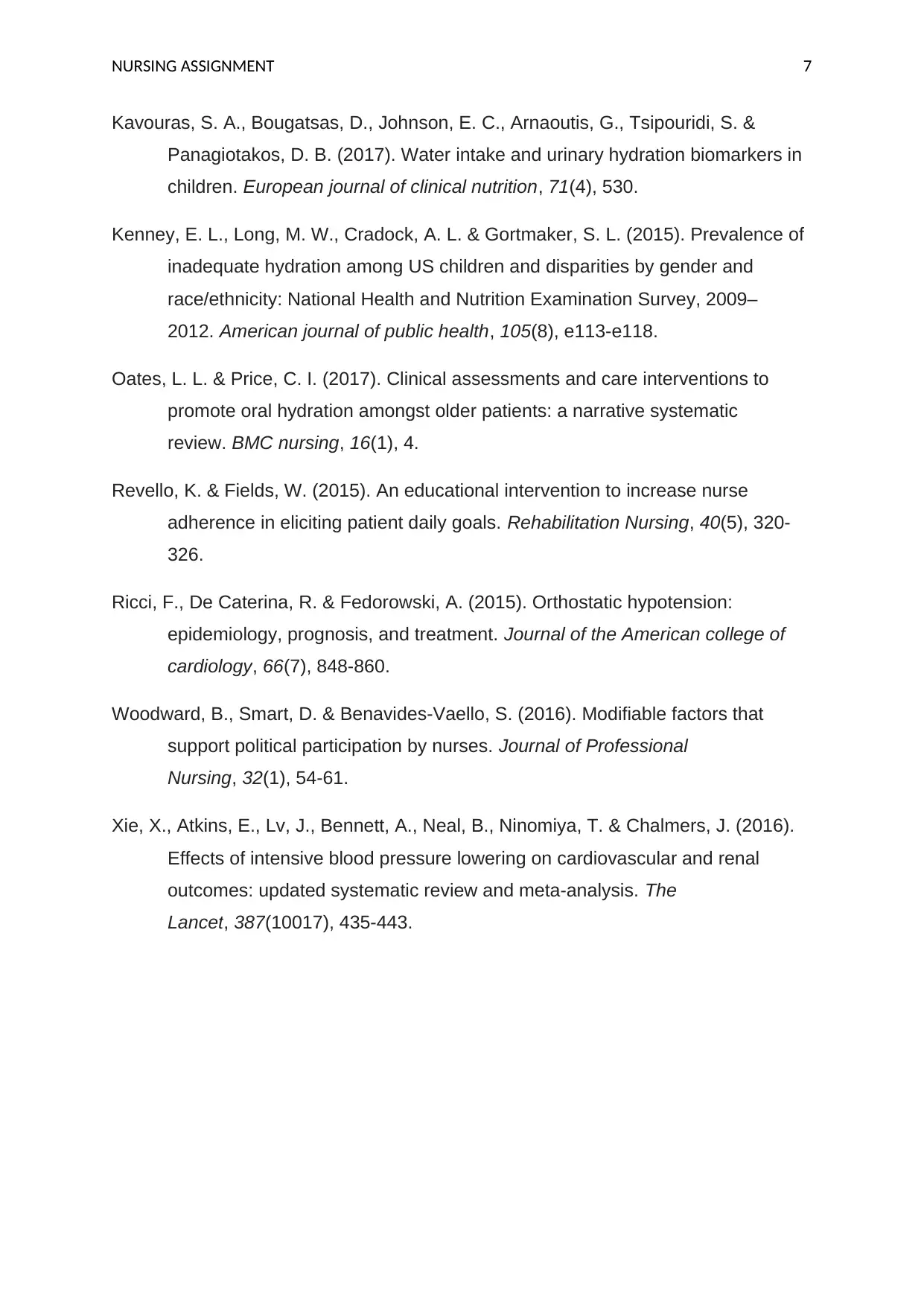
NURSING ASSIGNMENT 7
Kavouras, S. A., Bougatsas, D., Johnson, E. C., Arnaoutis, G., Tsipouridi, S. &
Panagiotakos, D. B. (2017). Water intake and urinary hydration biomarkers in
children. European journal of clinical nutrition, 71(4), 530.
Kenney, E. L., Long, M. W., Cradock, A. L. & Gortmaker, S. L. (2015). Prevalence of
inadequate hydration among US children and disparities by gender and
race/ethnicity: National Health and Nutrition Examination Survey, 2009–
2012. American journal of public health, 105(8), e113-e118.
Oates, L. L. & Price, C. I. (2017). Clinical assessments and care interventions to
promote oral hydration amongst older patients: a narrative systematic
review. BMC nursing, 16(1), 4.
Revello, K. & Fields, W. (2015). An educational intervention to increase nurse
adherence in eliciting patient daily goals. Rehabilitation Nursing, 40(5), 320-
326.
Ricci, F., De Caterina, R. & Fedorowski, A. (2015). Orthostatic hypotension:
epidemiology, prognosis, and treatment. Journal of the American college of
cardiology, 66(7), 848-860.
Woodward, B., Smart, D. & Benavides-Vaello, S. (2016). Modifiable factors that
support political participation by nurses. Journal of Professional
Nursing, 32(1), 54-61.
Xie, X., Atkins, E., Lv, J., Bennett, A., Neal, B., Ninomiya, T. & Chalmers, J. (2016).
Effects of intensive blood pressure lowering on cardiovascular and renal
outcomes: updated systematic review and meta-analysis. The
Lancet, 387(10017), 435-443.
Kavouras, S. A., Bougatsas, D., Johnson, E. C., Arnaoutis, G., Tsipouridi, S. &
Panagiotakos, D. B. (2017). Water intake and urinary hydration biomarkers in
children. European journal of clinical nutrition, 71(4), 530.
Kenney, E. L., Long, M. W., Cradock, A. L. & Gortmaker, S. L. (2015). Prevalence of
inadequate hydration among US children and disparities by gender and
race/ethnicity: National Health and Nutrition Examination Survey, 2009–
2012. American journal of public health, 105(8), e113-e118.
Oates, L. L. & Price, C. I. (2017). Clinical assessments and care interventions to
promote oral hydration amongst older patients: a narrative systematic
review. BMC nursing, 16(1), 4.
Revello, K. & Fields, W. (2015). An educational intervention to increase nurse
adherence in eliciting patient daily goals. Rehabilitation Nursing, 40(5), 320-
326.
Ricci, F., De Caterina, R. & Fedorowski, A. (2015). Orthostatic hypotension:
epidemiology, prognosis, and treatment. Journal of the American college of
cardiology, 66(7), 848-860.
Woodward, B., Smart, D. & Benavides-Vaello, S. (2016). Modifiable factors that
support political participation by nurses. Journal of Professional
Nursing, 32(1), 54-61.
Xie, X., Atkins, E., Lv, J., Bennett, A., Neal, B., Ninomiya, T. & Chalmers, J. (2016).
Effects of intensive blood pressure lowering on cardiovascular and renal
outcomes: updated systematic review and meta-analysis. The
Lancet, 387(10017), 435-443.
1 out of 8
Related Documents
Your All-in-One AI-Powered Toolkit for Academic Success.
+13062052269
info@desklib.com
Available 24*7 on WhatsApp / Email
![[object Object]](/_next/static/media/star-bottom.7253800d.svg)
Unlock your academic potential
Copyright © 2020–2025 A2Z Services. All Rights Reserved. Developed and managed by ZUCOL.





